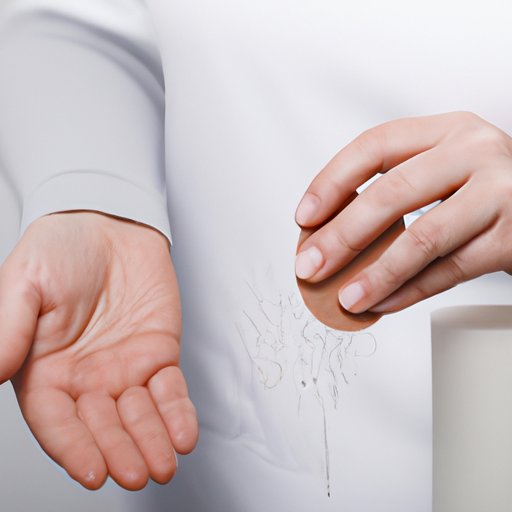
I. Introduction
Yeast infection is a common condition that affects millions of women and men worldwide. This infection occurs when the balance of yeast and bacteria in the body is disrupted, leading to an overgrowth of Candida yeast. While the symptoms of yeast infection can be uncomfortable and even painful, the good news is that the infection can be easily treated with medications and home remedies.
To effectively manage yeast infection, however, it is crucial to recognize its symptoms as early as possible. This article offers a comprehensive guide to the signs and symptoms of yeast infection, what causes it, and how to prevent and treat the infection.
II. The Telltale Signs: Recognizing Symptoms of Yeast Infection
The most common symptom of yeast infection is vaginal itching and soreness. Other symptoms include:
Vaginal itching and soreness
This is usually the first sign of yeast infection. Women experiencing yeast infection often feel an intense itching, soreness, or burning in and around the vagina. These sensations may be mild or severe and can make it hard to concentrate or even sleep.
Pain during sexual intercourse
Yeast infection can cause pain and discomfort during sexual intercourse. Women may experience pain or burning sensations during penetration or just after intercourse. These symptoms can lead to a decline in sexual satisfaction and can put strain on relationships.
Burning sensation during urination
A burning sensation during urination is another common symptom of yeast infection. Women may experience a painful burning or stinging sensation when they urinate. This symptom can be especially uncomfortable and can make it hard to carry out daily activities.
Redness and swelling of the vulva
Yeast infection can cause redness, swelling, and irritation of the vulva, which is the outside part of the female genitalia. This symptom can be particularly uncomfortable and can make it difficult to wear tight-fitting clothing or engage in physical exercise.
Cottage cheese-like discharge
Women with yeast infection may also experience an unusual discharge from the vagina that resembles cottage cheese in texture and color. The discharge may be thick and white and may have a strong odor. This symptom can be embarrassing and alarming for many women.
III. Yeast Infection 101: Understanding and Identifying Symptoms
Candida yeast is a type of fungus that is found naturally in the body. However, when the immune system is weakened or other factors disrupt the balance of microorganisms in the body, Candida overgrowth can occur. This leads to yeast infection.
Common factors that can contribute to yeast infection include:
- Taking antibiotics or other medications that kill good bacteria
- Pregnancy
- Diabetes
- High levels of stress
- Use of certain hygiene products
- Wearing tight or synthetic clothing
There are different types of yeast infection, including:
- Vaginal yeast infection
- Oral thrush
- Diaper rash in babies
- Jock itch in men
Men can also experience symptoms of yeast infection, including:
- Redness, itching, and swelling of the penis
- Burning sensation during urination or ejaculation
- Pain and discomfort during sexual intercourse
IV. When Things Go Awry: A Comprehensive Guide to Yeast Infection Symptoms
If left untreated, yeast infection can lead to more serious health problems. Women who have untreated yeast infection are at higher risk of developing pelvic inflammatory disease, a condition that can cause infertility, chronic pelvic pain, and other complications.
Infants and children can also develop yeast infection, especially in the diaper area. Symptoms in infants and children include:
- Red, uncomfortable rash on the diaper area, genitals, thighs, or buttocks
- Patches of pus-filled bumps that may spread to other parts of the body
- Fussiness and irritability
Pregnant women are more prone to yeast infection due to hormonal changes that affect the body’s normal balance of microorganisms. Pregnant women with yeast infection may experience symptoms such as:
- Increase in vaginal discharge
- Itching and burning in the vagina
- Pain during sexual intercourse
V. Uncomfortable Truths: Understanding the Symptoms of Yeast Infections and How to Deal with Them
Diagnosis of yeast infection usually involves a pelvic exam and testing of vaginal discharge. Women may also undergo a blood or urine test to rule out other possible conditions. Treatment depends on the severity of symptoms. Mild symptoms can be relieved with over-the-counter antifungal creams or prescription medications. Home remedies such as apple cider vinegar, probiotics, and tea tree oil may also be effective.
Prevention of yeast infection involves maintaining good hygiene practices, avoiding tight-fitting clothing, and taking antibiotics only when necessary. Women can also help prevent yeast infection by practicing safe sex and by avoiding douching or using scented hygiene products.
VI. From Itching to Discharge: Common Symptoms of Yeast Infection
Besides the symptoms mentioned above, other possible symptoms of yeast infection include:
- Swelling and pain around the anus
- Soreness and irritation of the nipples
- Cracks or sores at the corner of the mouth
- Fatigue and low energy
It is important to distinguish yeast infection from other vaginal infections such as bacterial vaginosis, which has different symptoms. Bacterial vaginosis is characterized by a grayish-white discharge with a strong fishy odor.
VII. Conclusion
Yeast infection is a common condition that affects many people worldwide. Although it can cause discomfort and embarrassment, it can be easily treated with medications and home remedies. The key to effective management of yeast infection is recognizing its symptoms as early as possible. By maintaining good hygiene practices and adopting a balanced lifestyle, women and men can prevent yeast infection and enjoy good sexual health.
If you are experiencing any of the symptoms mentioned in this article, talk to your healthcare provider to determine the cause and appropriate treatment.




